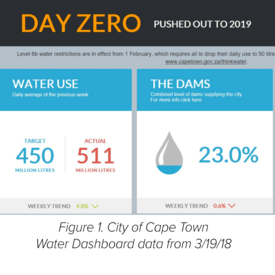
After months of living under the looming threat of “Day Zero”, Cape Town has tentatively pushed back the deadline of extreme water crisis for the remainder of the year. Day Zero, which had originally been scheduled for April 22, reflects the date when water levels in the city's major dams reaches 13.5% of their capacity. If this day arrived, taps would be shut off and Cape Town residents would need to stand in line to pick up their 25-liter daily ration of water.1 For perspective, this equivalent to the amount of water consumed in a four-minute shower.2
Drought-driven water shortages are a worldwide crisis. The cities at highest risk to run out of water include Jakarta (where the city is sinking from illegal groundwater extraction as sea levels around it rise), Mexico City (where taps are already turned off for many city citizens for parts of the day), Tokyo, London, and Miami.3 In California, almost 50% of the state is currently experiencing moderate drought.4
Cape Town is South Africa’s second largest city, with about 3.75 million metropolitan inhabitants.5 Since 2015, the city has been experiencing its worst drought in a century, the impact of which is compounded by continued population growth.1 As local dams continue to dry up, the city has attempted to conserve water by reducing consumption. The government has shut off unnecessary public water and invested in the construction of desalination plants and waterways from nearby sources. Individuals are recommended to limit their toilet flushing and opt for 90 second showers. In a city with a strong tourist economy, restaurants often no longer offer free water and bathroom sinks have been foregone for hand sanitizer.
Water consumption has historically been over 200 liters per capita in Cape Town, but government and community efforts have successfully reduced this to about 120 liters.6 In the US, average water consumption per capita is 300-350 liter/day.7 Cape Town may have delayed this crisis for now, but the issue poses a question to other drought-prone cities; how will they prepare for water shortages in a world with a changing climate?
Long term solutions to global water security will involve rainwater harvesting, wetlands conservation, and reshaping land use/agricultural practices.8 Responsible groundwater pumping and desalination of seawater can contribute to maintaining future sources of potable water. Individuals can also make an appreciable impact by reusing gray water for non-potable applications – reuse for gardening, toilet flushing, or laundry can reduce indoor water demand by 36%.9 By increasing awareness and individual conservation, improving infrastructure, and investing in technology, we can ensure access to water for future generations.
References:
[1] https://www.cnn.com/2018/02/01/africa/cape-town-water-crisis-intl/index.html
[2] https://news.nationalgeographic.com/2018/02/cape-town-running-out-of-water-drought-taps-shutoff-other-cities
[3] https://www.bbc.com/news/world-42982959
[4] https://droughtmonitor.unl.edu/CurrentMap/StateDroughtMonitor.aspx?CA
[5] https://www.statssa.gov.za/?page_id=1021&id=city-of-cape-town-municipality
[6] https://matadornetwork.com/read/cape-town-may-averted-major-water-crisis-history
[7] https://water.usgs.gov/edu/qa-home-percapita.html
[8] https://globalnews.ca/news/4092185/water-shortage-un-2050
[9] https://thefutureofthings.com/11039-can-cities-protect-drought


![Join Sterlitech at BIO 2024 [Booth #5558]: Exploring the Future of Biotechnology](https://www.sterlitech.com/media/magefan_blog/b4.jpeg)

